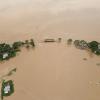
In Bangladesh, annual flooding affects millions of people, particularly those in rural riverine communities. These communities have developed resilience strategies over generations to cope with flooding and erosion, but with increasing hazards and land pressures, the effectiveness of these strategies is uncertain. A recent study evaluated the resilience of 35 such communities in the country.
Strong evidence on rising climate-related risks, along with first evidence of adaptation limits, is challenging conventional approaches to managing disaster and climate-related risk in populations around the world. In hot spot locations, addressing increasingly existential risks requires a step change toward transformational approaches to disaster risk management and climate change adaptation.
A recent study led by 2022 IIASA Young Scientists Summer Program (YSSP) alumna, Amelie Paszkowski from Oxford University, in collaboration with Reinhard Mechler and Finn Laurien from the Systemic Risk and Resilience Research Group in the IIASA Advancing Systems Analysis Program, and former IIASA Scientific Advisory Committee Chair, Jim Hall, investigated the issue in one such hot spot – Bangladesh.
Although communities in Bangladesh have over generations developed resilience strategies, considered as the combination of absorptive, adaptive, and transformative approaches, increasingly severe risks amplified by climate change threaten vulnerable communities and pushes them to consider planned relocation to safer places. While it is not clear whether such strategies are sufficient to generate resilience in the face of increasing hazards and growing pressures for land, understanding the capacity of communities to deal with transformational change in hot spot locations is increasingly needed.
The study, which applied the systems-based Flood Resilience Measurement for Communities (FRMC) measurement framework co-created by IIASA and partners of the Zurich Flood Resilience Alliance, quantifies community resilience to flooding and erosion for 35 of the most poverty-stricken and exposed communities in riverine Bangladesh. The findings show that efforts to generate community-led resilience have largely focused on absorbing shocks and adapting to a changing climate including the use of flood barriers and sandbags, raising of homesteads, building walls around homesteads, and locally diverting flood waters.
Nonetheless, some potential for considering transformational measures has been identified as well, such as improved community organization, cooperative longer-term planning, and planned temporary outmigration during floods to align with and complement ongoing community-centered efforts to enhance rural resilience in riverine Bangladesh.
"In the face of mounting climate threats and a rapidly growing population in the region, climate risks pose existential challenges to Bangladesh's rural communities, as well as many communities in other vulnerable regions and countries. Our research, co-created with community practitioners, underscores the need to better consider and support transformative solutions that blend modern and inclusive strategies with traditional knowledge that, to some extent, could empower these communities to weather the storms ahead," concludes Mechler, who leads the Systemic Risk and Resilience Research Group at IIASA.
Reference
Paszkowski, A., Laurien, F., Mechler, R. & Hall, J. (2024). Quantifying community resilience to riverine hazards in Bangladesh. Global Environmental Change 84, e102778. 10.1016/j.gloenvcha.2023.102778 [pure.iiasa.ac.at/19234]
News

17 July 2024

